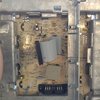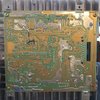I'm repairing The Glorious Deathmobile Mark II's amplifier (pulled from a '96 SHO), and TLDR needs new caps.
Now, There's a bunch of ceramic discs simply labeled "220" with a small dot underneath the number. I assume that's 220pf, but any other spec is a mystery to me. I'd like to replace them with something a little more "audiophile", and although I've found a bunch of info online, nothing is leading me to a definite replacement for this exact cap/application.
Also, a few of these caps bridge the + and - sides of the audio, on both the input and the output of the amp IC. Would these be the coupling caps?
Another issue...when I tested some of the larger Electrolytic caps with my cap meter, I was getting wildly unsteady readings. Everytime I put the probes to it (removed from the circuit) I got a completely random number. What's up with that?
Now, There's a bunch of ceramic discs simply labeled "220" with a small dot underneath the number. I assume that's 220pf, but any other spec is a mystery to me. I'd like to replace them with something a little more "audiophile", and although I've found a bunch of info online, nothing is leading me to a definite replacement for this exact cap/application.
Also, a few of these caps bridge the + and - sides of the audio, on both the input and the output of the amp IC. Would these be the coupling caps?
Another issue...when I tested some of the larger Electrolytic caps with my cap meter, I was getting wildly unsteady readings. Everytime I put the probes to it (removed from the circuit) I got a completely random number. What's up with that?







